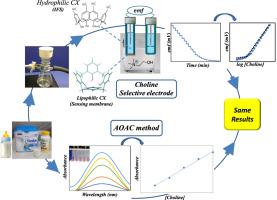Talanta ( IF 5.6 ) Pub Date : 2020-07-17 , DOI: 10.1016/j.talanta.2020.121409 Mohamed K. Abd El-Rahman , Gloria Mazzone , Amr M. Mahmoud , Emilia Sicilia , Tamer Shoeib

|
Choline (Ch+), is a vitamin-like essential water-soluble organic micronutrient. The US-FDA requires that infant formula not made from cow's milk must be supplemented with Ch+. Direct determination of Ch+ in milk powders and infant formulas is a challenging task due to the lack of a detectable chromophore, its existence in free and complexed forms as well as the presence of multi-analytes in these complex matrices. Here, an enzyme-free potentiometric ion selective electrode (ISE) with high selectivity for Ch+, a linear range from 0.03 μM up to 1 mM, a 0.061 μM detection limit (LOD) and a typical response time less than 5 and no greater than 60 s is developed for monitoring of Ch+ in infant formula and milk powders. To achieve these ISE parameters we relied on the ability of calixarenes and its derivatives to form host-guest complexes with the positively charged quaternary ammonium moiety of Ch+. We employed a lipophilic (membrane-compatible) calixarene as an ionophore in the sensing membrane phase to provide a molecular receptor for Ch+ capable of selective binding; while utilizing, hydrophilic (water-soluble) p-sulfonated calixarene as a buffering agent to optimize the inner filling solution to reduce transmembrane Ch+ fluxes. All the calixarene structures and their complexes with Ch+ were optimized at the density functional theory (DFT) level and the Gibbs free energies for the inclusion of Ch+ into the calixarenes were calculated. The prepared sensor was shown to selectively respond only to Ch+ in the presence of all other interferents in the tested matrices with results that are not statistically significantly different for either accuracy or precision relative to the much more laborious official AOAC 1999 coupled enzymatic–spectrophotometric method. The proposed method is highly selective, non-enzymatic, requires no derivatization or incubation steps, offers a fast response time, and has the potential of portability for in situ analysis, while being relatively cost effective and non-laborious.
中文翻译:

新型胆碱选择性电化学膜传感器及其在奶粉和婴儿配方食品中的应用
胆碱(Ch +),是一种类似维生素的必需水溶性有机微量营养素。美国食品和药物管理局要求非牛奶制成的婴儿配方奶粉必须补充Ch +。由于缺乏可检测的生色团,游离和复杂形式的存在以及这些复杂基质中存在多种分析物,因此直接测定奶粉和婴儿配方食品中的Ch +是一项艰巨的任务。此处是对Ch +具有高选择性,0.03μM至1 mM的线性范围,0.061μM检测限(LOD)的无酶电位离子选择性电极(ISE),典型响应时间小于5且不大于监测Ch +的时间超过60秒在婴儿配方奶粉和奶粉中。为了获得这些ISE参数,我们依靠杯芳烃及其衍生物与Ch +带正电的季铵部分形成客体复合物的能力。我们在传感膜相中采用亲脂性(膜相容性)杯芳烃作为离子载体,以提供能够选择性结合的Ch +分子受体。同时利用亲水性(水溶性)对磺化杯芳烃作为缓冲剂来优化内部填充溶液,以减少跨膜Ch +通量。所有杯芳烃结构及其与CH +的配合物在密度泛函理论(DFT)级别对它们进行了优化,并计算了将Ch +包含在杯芳烃中的吉布斯自由能。结果表明,准备好的传感器在被测基质中所有其他干扰物的存在下仅对Ch +有选择性地响应,结果与相对费力的官方AOAC 1999酶促分光光度法相比,其准确性或精密度均无统计学差异。 。所提出的方法是高度选择性的,非酶促的,不需要衍生化或孵育步骤,提供了快速的响应时间,并且具有可移植用于原位分析的潜力,同时相对成本有效且不费力。











































 京公网安备 11010802027423号
京公网安备 11010802027423号